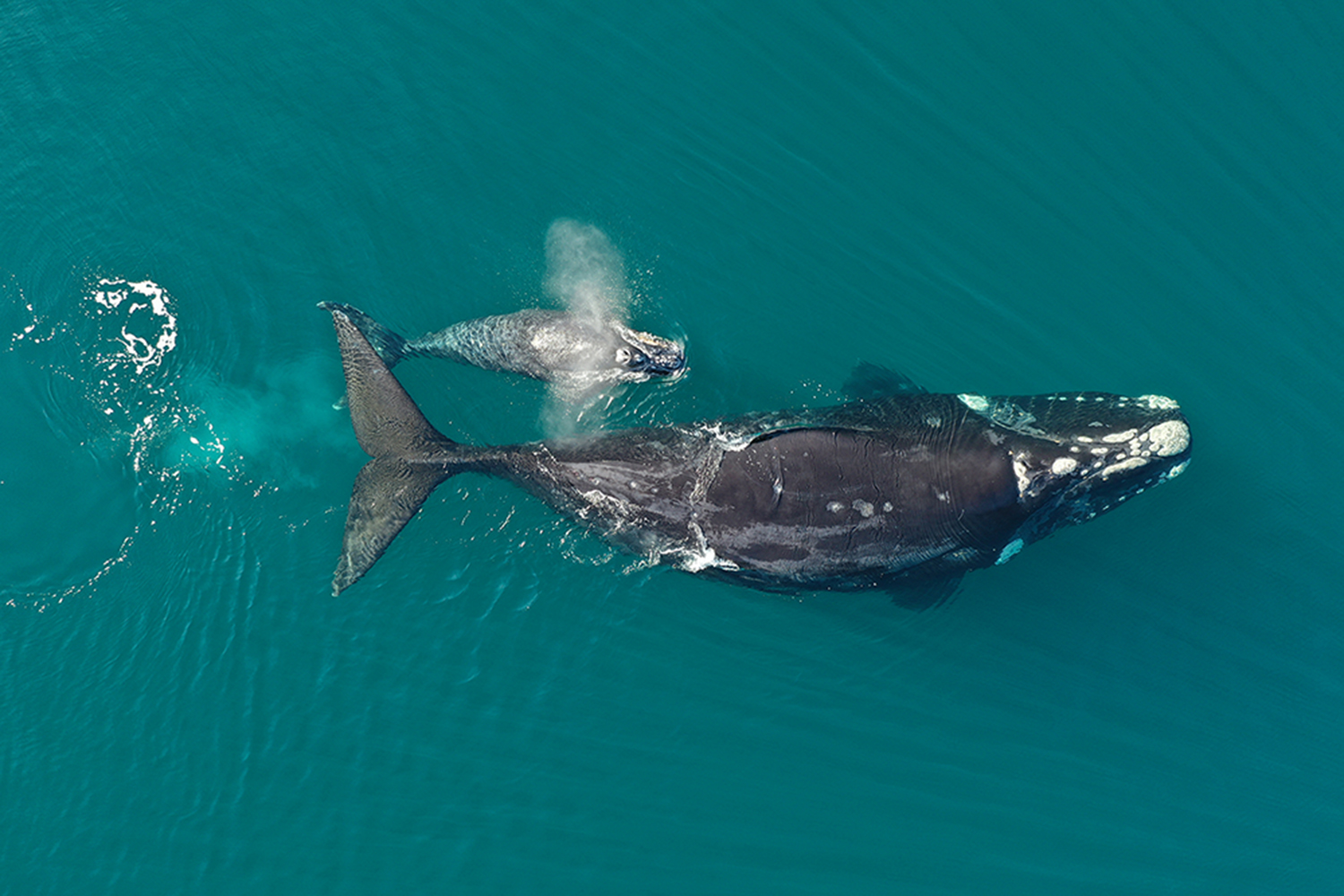The 9th season of this collaborative project, which has followed the migratory paths of southern right whales in the southern seas since 2014, has now begun. One of the discoveries of last year´s season was the tracking of a whale into the Pacific Ocean, something never recorded before then. The whereabouts of the whales can be followed daily at https://siguiendoballenas.org/en/home/

Monday November 4, 2024 – The Southern Right Whale is a migratory species which travels long distances, sometimes thousands of miles, between the areas where it feeds and where it breeds. With cutting-edge technology the “TrackingWhales” project obtains key information on this species and its movements in the marine environment. This research is possible through the combined effort of governmental organizations, academic institutions and NGOs, and has recently launched its ninth season in Peninsula Valdés, Chubut, Argentina.
This tracking season began in September, 2024, when new generation satellite transmitters were deployed on 10 Southern Right Whales in Golfo Nuevo. Six of these whales have already left the breeding ground and are now traveling to their feeding areas, while the rest (two whales) remain in the tranquil waters of the gulf.
For fast and easy identification, each tracked whale is given a name. The names chosen this year are chemical elements from the periodic table of elements. Seven adult females with calves were given the names Kalium, Moscovium, Neptunium, Niquel, Sulfurium, Tantalus, and Titanium; one solitary individual of unknown sex was named Rubidium; and two tagged juveniles were given the names Aurum and Platinum. The travels of these 10 whales can be seen at https://siguiendoballenas.org/en/home/
Tracking these whales via satellites allows us to learn how they utilize the southwest Atlantic Ocean and the sub-antarctic seas during their travels searching for food. This information is crucial to identify key areas in their life cycles, to support Marine Protected Areas, and to regulate activities such as fishing, oil exploration and extraction, as well as shipping lanes, all of which could seriously impact the species.
IMPORTANT DISCOVERIES DURING LAST SEASON
The 2023-2024 season brought novel discoveries, such as the migratory path of Atenea, the first tracked whale to connect the Atlantic and Pacific Oceans. This event demonstrated not only the migratory plasticity of this species, but also the importance of continuing these efforts to better understand the movements of southern right whales at the populational level.
During the eighth season we also confirmed that 4 of the 16 whales tracked had been previously identified by photo-identification, and were thus in the catalog of individuals recognized by their unique pattern of head “callosities”, similar to the fingerprints of humans. One of these whales was Eos, identified for the first time in 1979 as an adult, and resighted over the years with six calves. Her 2023 calf shows she continued in her reproductive stage.
Satellite tracking also revealed that Eos traveled to the Blue Hole, an area which encompasses the most productive ocean area in the southern hemisphere, and that functions as a “supermarket” for many marine species. The Blue Hole is scheduled to be declared a Bentonic Marine Protected Area by the Senate of Argentina in 2024.
A DECADE OF INVESTIGATIONS TO CONSERVE THE WHALES
When the present season of satellite tracking comes to an end, the Project, begun in 2024, will have studied the migration paths of 115 whales. The routes taken over the most recent seasons can be viewed at https://siguiendoballenas.org/en/home/
ABOUT THE PROJECT
The Tracking Whales project is possible thanks to the combined efforts of several institutions from Argentina, Brazil, Denmark and the United States: Laboratorio de Mamíferos Marinos del Centro para el Estudio de Sistemas Marinos (CESIMAR-CENPAT-CONICET), Centro de Investigación Aplicada y Transferencia Tecnológica en Recursos Marinos Almirante Storni (CIMAS-CONICET), Facultad de Ciencias Marinas (FaCiMar) Universidad Nacional del Comahue, Fundación Patagonia Natural, Instituto Aqualie, Instituto de Conservación de Ballenas (ICB), Cooperative Institute for Climate, Ocean and Ecosystem Studies (CICOES) of the University of Washington, Marine Ecology and Telemetry Research, and National Oceanic and Atmospheric Administration of the United States, Southern Right Whale Health Monitoring Program, University of California, Davis – Wildlife Health Center, Wildlife Conservation Society Argentina (WCS), Greenland Institute of Natural Resources of Denmark, Wildlife Computers, and the experienced captain, Federico Arribere.
This project is financially supported by the Office of Naval Research and the National Oceanic and Atmospheric Administration of the United States, with contributions from organizations in Argentina, Brazil and the United States. It is endorsed by the International Whaling Commission through its Management and Conservation Plan for Southern Right Whales in the Southwest Atlantic, the Argentina Ministry of Foreign Affairs, the governments of Chubut and Rio Negro provinces, and the National Coastguard. The project receives information and photographic contributions from the Whale Watching Captains Association and the Community of Puerto Pirámides, as well as the Association of Watersports Services from San Antonio Oeste.
To learn more, visit https://siguiendoballenas.org/en/home/
PRESS CONTACTS:
- Debora Mazzola, Press WCS Argentina, +11 4064-8827, dmazzola@wcs.org
- Marcela Uhart, Director Latin America Program, Wildlife Health Center, University of California Davis, +54 9 280-4696332, muhart@ucdavis.edu
- Santiago Fernández, Laboratorio de Mamíferos Marinos, CESIMAR CCT CONICET CENPAT, +54 9 3401-434922, sfernandez882@gmail.com
- Belén Braga, Responsable de Comunicación y Prensa, Instituto de Conservación de Ballenas, +54 9 11 6535 4520, braga@icb.org.ar
- Florencia Rey, Fundación Patagonia Natural, +5492804305115, florenciarey95@gmail.com
- Alexandre Zerbini, Senior Scientist, Marine Ecology and Telemetry Research, University of Washington and NOAA, +1 206 3517311, zerbini@noaa.gov